Hi-Fi Hall of Fame
Technology Inductee
Compact Cassette

Introduction
Our next nominee is a technology that started out as a low fidelity medium, but became one of the world’s most successful music formats, while also evolving into a high fidelity technology. We are talking about the Compact Cassette, or simply the “cassette”.
The cassette, a seemingly simple invention, revolutionized the way we experienced audio. Invented by Lou Ottens and his team at Philips in 1962, it transformed the cumbersome reel-to-reel format into a portable and user-friendly system. But beneath its unassuming plastic shell lies a world of engineering marvels that pushed the boundaries of audio fidelity in a surprisingly compact form.
Let’s take a look at one of the most popular audio formats of all time, the cassette!
The Cassette’s Humble (Low Fidelity) Beginnings
By the 1960s, audio recording on magnetic tape had been around for many years. Reel-to-reel recorders were used in professional applications such as radio stations and music studios, and a few audiophiles had recorders in their home Hi-Fi systems. These recorders provided good quality but they were large, expensive, and loading the tapes into the machine was difficult to do.

In the early 1960s, Dutch manufacturer Philips set out to create a new tape recording format. Their goal was to create a smaller, more convenient alternative to bulky reel-to-reel tape recorders. Teams of Philips engineers in Vienna, Austria, and Hasselt, Belgium, competed to develop a new tape cartridge design.
The winning design
By 1962, Philips had reviewed a number of cassette designs, and ultimately chose the two spool design from the Belgian team led by engineer Lou Ottens. This design became the iconic Compact Cassette. The cassette was introduced in Europe in 1963 and in the United States in 1964.

In addition to the cassette itself, Philips released the first cassette player, the Philips EL 3300. This was a simple, portable recorder, good for capturing the spoken word, but not really suitable for high fidelity music. Sales of the recorder soared – Philips sold more than 2 million cassette recorders by 1968. By the early 1970s, cassettes had become the dominant format for tape recorders.


However, Philips wasn’t alone in this race. They faced competition from Telefunken and Grundig, two companies which had developed alternative (and incompatible) cassette formats. To ensure that their cassette design would be successful in the market, Philips made a key decision: they licensed the Compact Cassette format to Sony, free of charge. This strategic move secured widespread adoption by Japanese manufacturers, ultimately propelling the Compact Cassette to become the global standard for audio recording.

Evolution to High Fidelity
For the next few years, cassettes became popular for recording voice and low fidelity music, but the format wasn’t really capable of high fidelity reproduction. Nonetheless, equipment manufacturers saw the potential in this new format, and began developing enhancements that would make the cassette “Hi-Fi”.
The engineers had to address a number of challenges. First, they had to squeeze two channels of audio onto that narrow tape, to produce stereo. Second, they needed to increase the frequency response, to cover the entire audible frequency range of music. Third, they had to reduce the “wow and flutter” (speed variations) of the tape, so that the music’s tempo was correct. Finally, they had to reduce the background noise, to eliminate the “hiss” produced during recording and playback.
Four tracks for stereo sound
To solve the stereo problem, a “four track” version of the cassette was developed, to allow stereo sound on both sides of the tape. This required miniaturizing the record, playback, and erase heads to fit the very narrow tracks.
Novel tape formulations boosted performance
The quality of the magnetic tape significantly impacts the fidelity of the recorded sound. Early cassettes used ferric oxide, which offered a decent balance between cost and performance. However, these tapes exhibited higher noise levels and limited high-frequency response. The introduction of chromium dioxide (CrO2) tapes, also known as “chrome” tapes, addressed these issues. Chrome tapes offered superior high-frequency response and lower noise, but required a higher bias current during recording for optimal results. Metal tapes, the pinnacle of cassette tape technology, boasted even wider frequency response and lower noise due to their formulation with metal particles. However, they were the most expensive option and demanded even more specific recording parameters for peak performance.
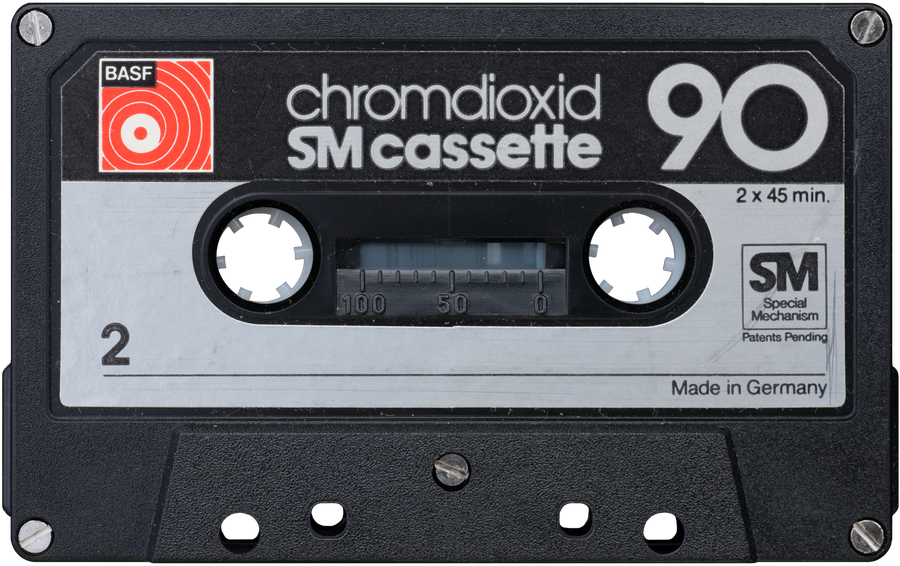
The recording/playback “head” in a cassette recorder plays a crucial role in capturing the electrical audio signal and transforming it into a magnetic pattern on the tape. The quality of the head material, its gap size, and its frequency response directly affect the fidelity of the recording. Engineers made continuous improvements to the head material and gap size to enhance performance.
Dolby to the rescue
While advancements in tape formulations and head design improved fidelity, tape “hiss” remained a challenge. To combat this, various noise reduction systems were developed. Dolby Noise Reduction became the most popular. Dolby boosts high frequencies during recording, then reduces them (along with the tape hiss) on playback, for a clearer signal.
Finally, to solve the problem of speed variations (“wow” and “flutter”), cassette decks were developed with multiple motors and precisely manufactured capstans and pinch rollers.
Mission Accomplished: the Hi-Fi Cassette
By 1971, all of this work began to pay dividends, and the first high fidelity cassette deck was introduced. Advent introduced the Model 201 which used a Wollensak transport, Dolby noise reduction, and chromium dioxide tapes to produce high quality recordings. Reviewers and customers were very impressed with the audio quality. Suddenly the cassette format was taken seriously for musical use, and this started the era of high fidelity cassette decks.
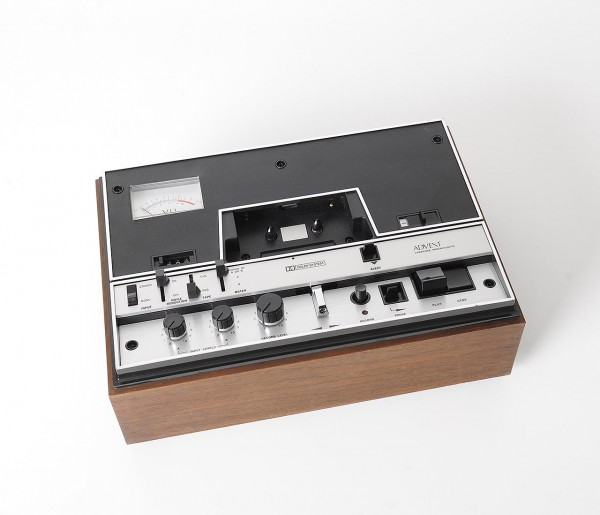
Other manufacturers quickly followed with their own high performance cassette decks. TEAC released the models A-360 and A-450. Both decks had bias and equalization switches to optimize playback for different tape formulations. The A-450 was sometimes referred to as “The Challenger” as it was their first deck to rival the performance of open reel tape decks.


Sony entered the Hi-Fi cassette market with the TC-131SD and TC-134SD. These were equipped with “Ferrite” heads for improved performance and longevity, and Dolby noise reduction.

Norwegian manufacturer Tandberg produced the model TCD-300 which used separate motors for the capstan, supply reel, and take-up reel. This provided a stable and consistent tape movement which contributes to better sound quality.

Nakamichi really raised the bar when they introduced the model 1000, which was called the “Tri-Tracer”. It was one of the first three head cassette decks available to consumers. Using separate heads for erase, record, and playback allowed for significant improvements in recording quality and fidelity compared to two head decks. The Nakamichi 1000 was inducted into the Hi-Fi Hall of Fame in December 2023 (click here to view).

Beautiful Aesthetics, Brilliant Performance
Throughout the 1970s and 1980s, Hi-Fi cassette decks continued to evolve, with beautiful aesthetics, new technologies and capabilities, and ever improving audio performance. Let’s take a look at some of the outstanding cassette decks of the era.
The Yamaha TC-800GL received many honors for it’s beautiful wedge-shaped design which was designed by Italian architect Mario Bellini.

Bang & Olufsen always produced beautiful audio products. Shown here is the Beocord 9000, which employed a computer controlled calibration system to optimize the bias, equalization, sensitivity and VU meter calibration for each cassette automatically.

The Marantz 5220 cassette deck was designed to match Marantz’s line of receivers, amplifiers, and tuners. It sported a blacked-out metal faceplate with bold VU meters and a lighted cassette well for dramatic looks.

ReVox was best known for their open reel recorders, and they applied much of that expertise to produce some extraordinary cassette decks. They entered the cassette market later than the others (in 1981), but their first cassette deck was the outstanding B710. It was equipped with four motors, Dolby noise reduction, and LED meters.

By 1984, cassette technology was very highly evolved, and TASCAM produced the PORTA ONE ministudio. This was a portable, four track recording studio. It was inexpensive and easy to use. With this device, and others like it, musicians and producers could record and mix their own music anywhere.

Cassettes outside the Home
While the cassette was evolving into a Hi-Fi medium inside the home, it was also becoming very popular in settings outside the home. The cassette was small, portable, and rugged, and so it was well suited to applications outside the home. Manufacturers began developing car stereos, “boombox” stereos for parties and outdoors, and of course personal music players.
Only a few of these delivered a truly “Hi-Fi” level of audio performance, but they certainly helped to make the cassette popular, so let’s take a look at a few of these.
Car Stereo
The very first car stereo with a built-in cassette player was the Philips RN582, which was introduced in 1968. It was a very basic machine, without any form of noise reduction, but people liked the convenience of playing cassettes in the car. The cassette format was very popular and within a few years, cars were often equipped with built-in cassette players right from the factory, or the owner could add their own “after market” equipment to suit their taste and budget.
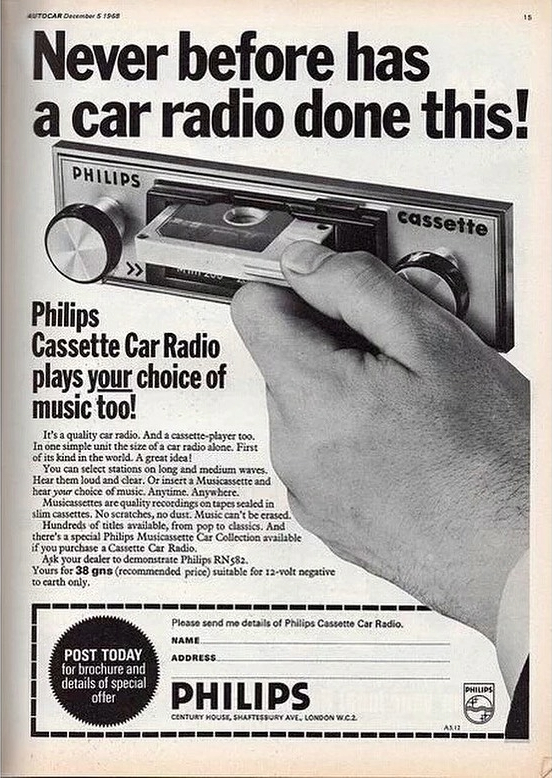
An example of a quality “after market” player was the Pioneer KE-5000, which was available by 1978. It featured Dolby noise reduction and could play chromium dioxide cassettes.

By the 1980s, there were some very capable car stereos available. An example is the Nakamichi TD700 which was equipped with Dolby B and Dolby C noise reduction, could play the latest metal tape formulations, had a magnetic clutch to keep wow and flutter to a minimum, and automatic azimuth adjustment.
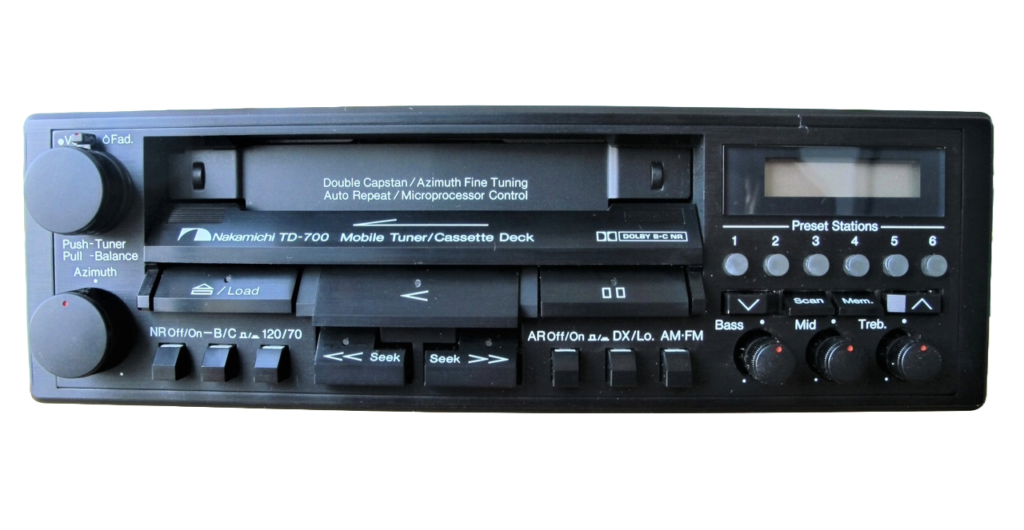
Portable Stereo / “Boombox”
The very first portable cassette player designed for room filling sound was produced by Philips, and was marketed as the Norelco “Radiorecorder” (model 22RL962). It could record and play cassettes, and had a built in amplifier and speaker.

Similar to the evolution of car stereos, portable stereo systems with cassette evolved over the next few years, incorporating new capabilities and superior audio performance. By the late 1970s, these players were powerful enough that they could play very loud, and they became known as “boomboxes”, for their thumping low frequency sound.
The vast majority of these stereos could not be considered “Hi-Fi”, but there were a couple that came very close. The Yamaha PC-8 was an enormous, heavy machine and included Dolby noise reduction, two way speakers, and relatively powerful amplifiers.

The Telefunken HiFi Studio 1 was likely the most “Hi-Fi” boombox ever produced, weighing in at 13 kilograms (over 30 pounds), with three way speakers, powerful amplifiers, and Telefunken’s proprietary noise reduction technology.
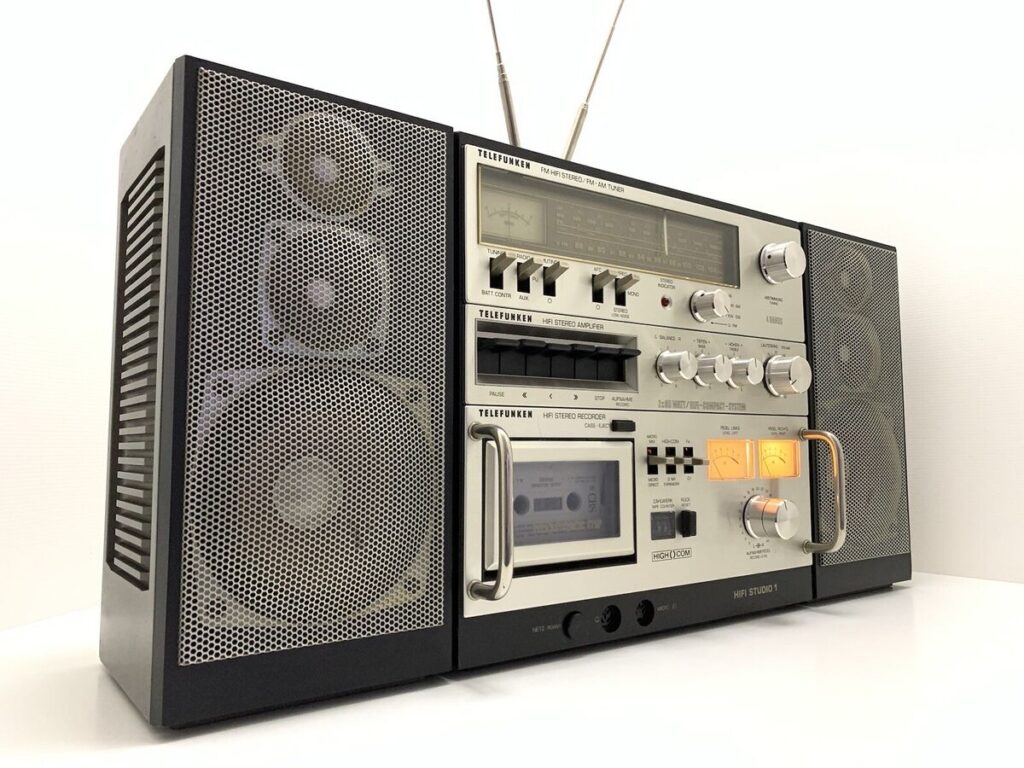
Personal Audio Player – the “Walkman”
The personal audio player, widely known as the Walkman, was arguably the cassette’s greatest success. The first Walkman was made by Sony, and revolutionized the way that people listened to music. The first Walkman, the TPS-L2, was a metal cased, blue-and-silver device. It was the world’s first low-cost portable stereo and went on sale in Japan on July 1, 1979.


Originally marketed under different names in various places, like “Soundabout” in the U.S. and “Stowaway” in the U.K., it became known as the Walkman everywhere soon after. The Walkman had a stereo playback feature and even included two mini headphone jacks, allowing two people to listen at the same time. Within a few years, the name “Walkman” was so successful that people everywhere simply used that name to describe portable cassette players.
Those early players were certainly not “Hi-Fi”, as the sound quality was rather poor. But just as home cassette decks improved steadily in the 1970s, portable cassette players also evolved quickly. In 1982, Sony introduced the WM-7, which incorporated three motors, electronic controls, automatic reverse, Dolby B noise reduction, and a “hold” function that blocked all the keys when set.

Seeing the success of the Sony Walkman line, other manufacturers began to produce their own versions. Toshiba, Sanyo, JVC, Akai, and Panasonic all had products in the market by 1982.
Panasonic introduced a model RQ-J20X which used “dbx” noise reduction rather than the traditional Dolby.

Sanyo offered the model MR-G1 which employed a unique pitch control to allow the user to make playback faster or slower.

Sony offered a “Professional” line of Walkmans, with top of the line build quality and features. An example is the WM-D6, which had Dolby C noise reduction, direct drive motors, and an LED level meter.

Aiwa was another manufacturer that produced superb cassette players. The Aiwa HS-PX30 was a Dolby C player with amorphous head and a simple parametric equalizer for optimal frequency response.

By the end of the 1980s, the performance of the top-of-the-line players was certainly “Hi-Fi”. The Sony WM-DD9 employed dual direct drive, quartz controlled motors, amorphous heads, a gold plated headphone jack, and other features.

If you’re interested in this topic, there is a fantastic website dedicated to the Walkman and other personal cassette players. It’s called “Walkmanland” and has a lot of pictures and statistics, along with a community of fans. Check it out here:
Commercial and Cultural Success
The cassette became so popular that for a period of time, prerecorded cassettes were outselling vinyl records. Blank cassettes were also sold in huge numbers, and people used the blanks for all sorts of purposes. What made the cassette such a commercial and cultural success? There were four main reasons…..
Accessibility and Affordability
Cassettes were cheaper to produce than records, making music accessible to a wider audience. This fostered the rise of independent labels and niche musical genres, which didn’t have a large enough audience to go through the major record labels. Punk rock, with its DIY ethos, thrived on the affordability of cassette production. Inexpensive blank tapes also fueled the mixtape culture, allowing friends to share their musical discoveries and create personalized experiences.


Democratizing Recording: The Power in Your Hands
Cassette recorders put the power of recording in the hands of the masses. People could record live concerts, radio shows, or create their own mixtapes, fostering a sense of personal control over music consumption. The cassette deck could record from records, from FM radio, from Compact Discs, even from other cassettes.

The Rise of the Mixtape: A Cultural Touchstone
The mixtape became a cultural phenomenon. It was a way to express affection, share musical discoveries, and curate a narrative through music. Mixtapes were exchanged between friends, lovers, and even strangers, creating a powerful emotional connection. Movies like “High Fidelity” cemented the mixtape’s place in pop culture, showcasing its ability to capture a moment in time and express deep emotions.

Beyond Music: A Platform for Ideas
Cassettes weren’t just for music. They were used for educational purposes, language learning, and capturing lectures and seminars. Stand-up comedians used cassettes to hone their routines, and bootleg recordings of live shows circulated amongst fans. Cassettes became a platform for sharing ideas, fostering underground scenes, and allowing voices outside the mainstream to be heard.
Demise of the Cassette
The cassette, of course, no longer enjoys the huge success that it once did. It didn’t have a single, sudden demise: it was a gradual decline caused by several factors. In fact, the cassette format was popular for around fifty years, which is a good long run for any technology. Let’s look at the final three decades for the cassette…..
The 1980s: The Compact Disc (CD) became very popular in the 1980s. CD offered superior sound quality and durability compared to cassettes. Consumers began to shift towards CDs, especially for pre-recorded music.

The 1990s: Cassette sales continued throughout the 90s, but at a decreasing rate. CDs became the dominant format for music listening, while cassettes were still popular for creating mixtapes and recording audio.
The 2000s: The rise of digital music formats like MP3s and the iPod in the early 2000s further eroded cassette usage. MP3 players and software made it easy to download and copy music, and to create “mixtapes” of MP3 songs. Streaming services later became even more popular for music consumption.
Sony announced the end of cassette Walkman production on 22 October 2010, mainly as a result of the emergence of MP3 players such as Apple’s iPod. These days, Sony uses the Walkman brand solely for its line of digital media players. That marked the end of the cassette as a dominant music format.
The Cassette: It’s not dead, it’s just resting
While the cassette is no longer the dominant medium that it once was, there are enough fans to keep the format alive. If you’re looking for vintage cassette decks, boomboxes, or portable “Walkman” players, there are lots for sale in flea markets, E-Bay, and other marketplaces. And if you’re looking for a new cassette deck or player, there are still a few in production. Here are a few examples.
TEAC offers two cassette decks. The TEAC W-1200 is a double well deck, suitable for making two tapes at a time or for dubbing. The TEAC AD-850-SE holds a CD player and cassette recorder, making it ideal for making cassette copies of CDs.


Click here to visit the TEAC website.
Marantz Professional division makes the PMD-300CP, a high end machine suitable for home or studio use. It is a dual-cassette deck that can make copies at normal or double speed, and it also connects to a computer via USB to allow you to make digital copies of your cassettes.
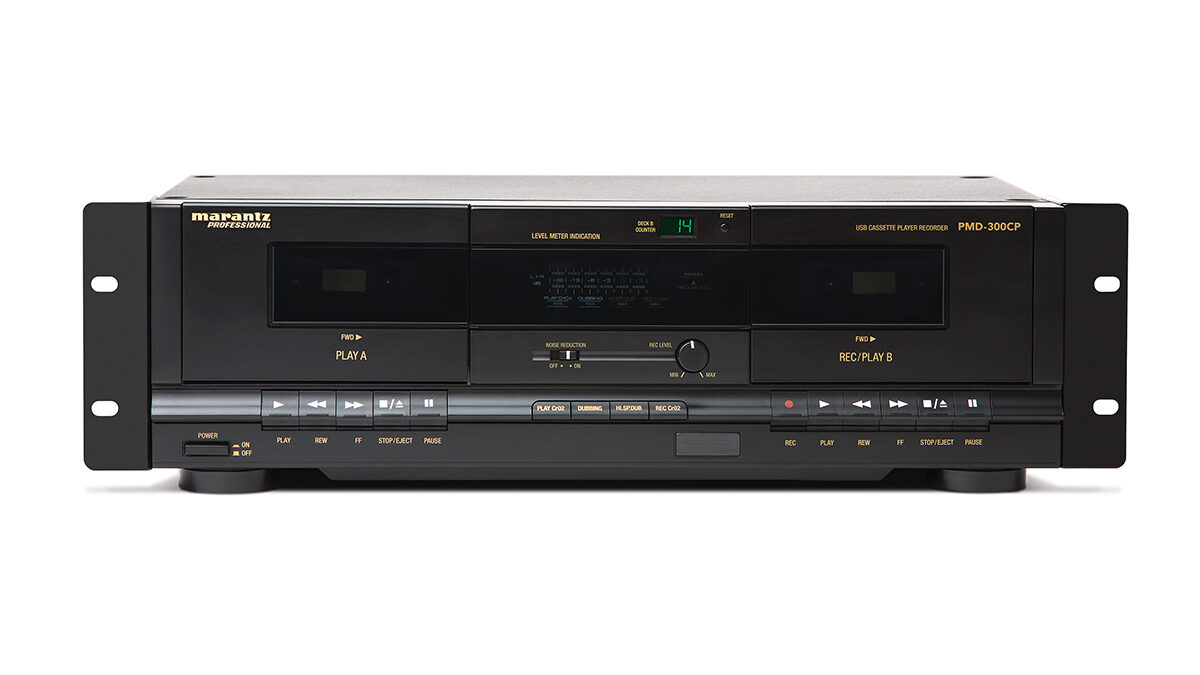
Click here to visit the Marantz Professional website.
A company called “High Fidelity Vinyl” offers a collection of portable players under the “We Are Rewind” brand.

Click here to visit the “We Are Rewind” website.
FiiO Elecronics makes a wide range of interesting audio products, including a portable cassette player called the CP-13.

Click here to visit the FiiO website.
The cassette boombox is nearly extinct, but there is still one company making new models. Ion Audio has the very “retro” looking “Street Rocker”.

Click here to visit the Ion Audio website.
Induction into the Hi-Fi Hall of Fame
The cassette is a rather unlikely technology to earn induction into the Hall of Fame. When first released, it was a decidedly low fidelity medium, suitable only for voice recordings. It was no match for the vinyl LP records or open reel tape recorders that were dominating the Hi-Fi market in the 1960s.
And yet, after a decade of steady improvements, the humble cassette had transformed into a format with Hi-Fi capabilities. For the next few years, enthusiasts started adding cassette decks to their systems, buying portable “boomboxes” for outdoors, personal “Walkman” players for when they were out and about, and car stereos with built-in cassette players.
Suddenly, the cassette was everywhere! People recorded copies of their favourite records to take with them and they created “mixtapes” with collections of their favourite songs. Others used the cassette to record sermons, political speech, comedy, and their garage band music.
Cassettes were inexpensive, rugged, ubiquitous, interoperable, portable, and in the right machine, capable of Hi-Fi audio. From the early 1970s until the digital age, the “Compact Cassette” was one of the most popular technologies in the world!
The cassette, along with the Walkman, also popularized an entirely new way of listening to music – by yourself, with a simple personal audio player, played through a pair of earphones. That first Walkman was superseded, first by the CD-based Discman, then by the MP3 player, and finally by the smartphone, but it was the cassette that started it all.
For all of these reasons, the Compact Cassette is inducted into the Hi-Fi Hall of Fame.